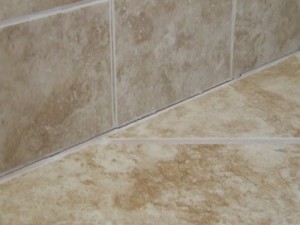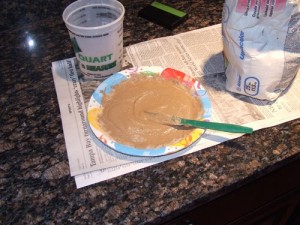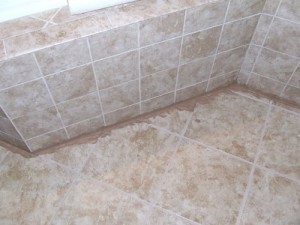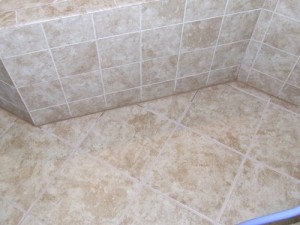How To Repair Hairline Cracks in Tile Grout Lines
How To Repair Cracked Grout


For example, where a tiled wall meets a tiled counter top or floor.We have this problem in or master bathroom in a few places on the whirlpool tub surround.
This problem tends to happen more often with new construction due to the drastic changes in moisture content in the framing materials. As the framing materials dry out then shrink, twist and become distorted. As a result the tiled surfaces will move and create cracking at the grout lines.
Repairing the hairline cracks in the grout lines is a fairly easy DIY project. (See below for recommendations on repairing larger cracks in grout using a Dremel 568 Grout Removal Kit).
Repairing Hairline Cracks In Grout


I’m choosing the quick and dirty method because I want to see if this will work. The simple method is to just fill the existing crack with grout. The more complicated method would require removing as much of the existing grout as possible and then re-grouting the joint completely.


Grout Cleanup


Repairing Wide Cracks in Grout
If you have wider cracks in the grout or missing grout then it’s time to consider removing the old grout and installing new grout between the tiles. You can use a simple Grout Removal Kit or 

Recent Posts
Framing Stick Nailer vs Coil Nailer
Which is Better a Stick Nailer or Coil Nailer? Framers have many choices in nailers…
How Many Roofing Nails Per Square of Shingles
Estimating How Many Nails for a New Roof When it comes to estimating materials for…
Composite / PVC Decking – Layout Tips & Advice
Composite / PVC Decking Layout Tips and Advice Composite and PVC decking have really changed…
Benefits of an ERV System (Energy Recovery Ventilator)
Benefits of ERV Systems (Energy Recovery Ventilator) If you're building a new home or doing…
Vermiculite Attic Insulation Abatement
Vermiculite Attic Insulation If your home was built before 1990 there is a chance it…
Nuisance Tripping of AFCI (Arc Fault) Circuit Breakers
Arc Fault (AFCI) Circuit Breakers Tripping Often An arc-fault circuit interrupter (AFCI) or arc-fault detection…
View Comments
I found your directions totally useless. "Just install new grout as if it were new construction" I could have figured that much all by myself! Thanks you have been a big help!!
Paul - Thanks for being such a colorful guy. If you look at the article, it was focused on hairline cracks. The last part of the article mentions wider cracks and gives a link to another article that shows how to grout tile in new construction. Sorry you felt the information was lacking. Good luck.
Paul; You must need glasses. I can't believe you bothered to respond so rudely and did not read his instructions carefully. He said this problem with the grout happens with new construction and I only read it once!
Hey Todd. I was wondering if you have any info on repairing grout on a pier and beam sub-floor. The tile went on nicely, but about a month later, the grout started coming out in chunks around the tiles. I did not put down any hardy backer. Do you think that could have been the problem, or do I just need to try a silicone based grout that comes in a tube? Thanks, Scott
Scott - Not really sure what you're referring to on the "pier and beam sub-floor". Can you be more specific? Sounds like a deflection issue to be honest.
Some grout has eroded in a very small area on one wall in my shower. Can I just put some grout in those areas ot will I need to regrout the entire shower?
Lonnie - You can grout just small areas. Before you do it I would clean the joint in that area and be sure that all the loose grout is removed. Once you know that the remaining grout is sound then apply the new grout. It's not likely that the color will match very well though.
Hi: I had ceramic tile put down on my kitchen counter--they removed the old counter and placed the tile, just as your description states, where the wall and counter meet, there are now cracks, I think those will be easy enough to fix but what I found troubling is that where the cracks are in the grout, they have entered the actual tile. Like some of the tiles are cracked now, can that be repaired without removing them? For instance, where the crack is present in the grout, it makes a zig zag crack in some areas which extends the white grout and then the actual beige tile has some crack. I have no idea why this happened. I hope I can fix it. I was worried there was water leaking someplace but I think the moisture as you state is the issue and it just continued like a crack can and went on to include not just the grout line but the tile itself. I almost had a heart attack when I saw it.
Kathleen - This actually sounds like a bigger problem. Grout typically cracks from two things, movement due to material shrinkage (pretty normal and what I wrote about) or too much movement in the sub-base. Because your tiles are cracking I think the later is the problem. Without knowing the specifics it sure sounds to me that the plywood sub-base that supports the tile is probably not stiff enough. If that's the case then the tile and grout can crack.
Do you know what the supporting sub-base is constructed of? Most people use a minimum of two layers of 3/4" plywood over the framing before tiling it.
The grout in my standing shower has cracked? Could it have nit meen sealed wirh sealent? And after I fill the cracks can I seal it even if it has already been saealed?
Thank you for your help
Elissa
Elissa - Grout does not crack due to lack of sealant. You should be able to repair the grout, then seal it again.
Good luck
Hi Todd. Our house is about 40 yrs old. We just did over the entie bathroom right down to the studs. We had radient heat put in the floor and hired a professional tile guy who tiled the entire bathroom. After only a few months, he grout is cracking around the tub, window and walls. On the floor it has even come out in small chunks. Do you think that the larger floor chunks could be due to the radient heat? Also, would hairline cracks appear only after a few month? Thanks.
Alysa - Without knowing all the details it's quite hard to determine the cause. However, in most situations extensive cracking and failure of grout on flat floors is a result of an inadequate sub-floor. Hairline cracks develop routinely in grout where two surfaces meet at 90 degrees, like wall/floor intersections, etc.
Radiant heat is not causing this issue unless the heat is causing a poor sub-floor to move too much under thermal stress.
What is the sub-floor? You really need a minimum of 3/4" plywood, glued, nailed (preferably screwed), then a tile backer, either cement board or a product like Ditra Schluter.
Hello. A couple of years ago, I had a cermaic tile floor put in my 1st floor. The grout lines now look terrible. The grout almost looks "pitted" and these areas collect dirt so it looks like I've got stained areas of grout throughout my house. The sales guy said that we didn't have to seal this grout because it was "special" grout. HA! How do I fill in all these pitted spots? I really need some help.
Thanks!
Sounds like the grout needs to be removed and re-installed. Grout doesn't last forever but it should get through 5 years or more unless there are really hard conditions. Removing grout and installing new grout isn't a very hard task if you're up for a DIY project.
It appears on the perimeter of my Powder Room- the grout gives off a ghosted feel (looks like baby powder on it) Grout color is cocoa. Is there anyway I can do a quick topical repair with grout overlay b/f the Holidays- grout on top of the existing grout. Cannot afford to have someone come in to do right now. The floor is honed marble rosa verona
Many Thanks!
I would scrub the grout, then try a sealer.
I just wanted to say thank you Todd. I found this very informative and just what I needed to know! Keep up the good work!
Hi Todd,
While I found your site extremely informative I am wondering... A little background, my home was built in 83, I think the bathroom is original to the house. Well the grout is chipping and is cracked. We will be renovating the bathroom next summer. I think the cracks are bad enough that I need to redo it, but I don't really see the point since we are going to tear it all out anyway. Do you think clear bathroom caulking woould do the trick?
Aimee - Are you asking what you can use between now and next summer? If so there are "sanded" caulking products available at most hardware/big box stores that you can use for a temp fix. Good luck.